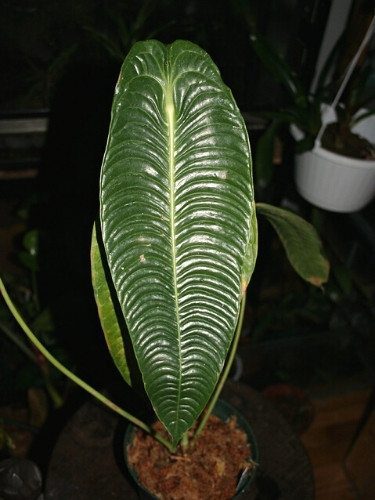The king anthurium (Anthurium veitchii) is a herbaceous, epiphytic, perennial species originating from the tropical forests of Colombia, renowned for its lush foliage. It features long upright petioles with pendant, narrow, leathery leaves. These leaves have an elongated heart-shaped form and a glossy dark green color. Additionally, they exhibit characteristic corrugations and undulations that give them a unique texture. When young, the leaves display shades of bronze to rusty colors. It’s important not to confuse the king anthurium with the queen anthurium, from the species Anthurium warocqueanum.

With slow growth, the leaves of the king anthurium can take around 3 months to fully develop, reaching up to 2 meters (6.5 feet) in length in its native habitat. Inflorescences appear throughout the year but are more common in spring and summer, although they hold little ornamental value. They are spadix-type inflorescences with a white to yellowish spathe, sometimes green or light green, and are situated beneath the foliage.
The king anthurium is primarily an indoor plant, but it can also be used in gardens. Whether in pots, planters, or hanging baskets, it’s perfect for decorating living rooms, bedrooms, offices, porches, or entryways. In landscaping, it can be placed on the branches of large trees or raised beds, always in spots protected from direct sunlight.
Keep in mind that this special anthurium is best appreciated when located at eye level, so using tall pots or placing them on elevated surfaces is advisable. Maintenance is simple, involving the removal of dead leaves, wiping the leaves with a clean damp cloth to remove dust, as well as repotting every two to three years in spring to refresh the substrate and rejuvenate the plant.

It should be cultivated in filtered light and protected locations. When exposed to direct sunlight, the foliage of the king anthurium will scorch, leading to the plant’s demise. It thrives in warm and humid climates, with temperatures between 16 to 27°C (61 to 81°F).
The ideal substrate is one suitable for epiphytes—light, porous, well-draining, with good moisture retention and rich in organic matter. Watering should be done when the top layer of the substrate is dry, being cautious to reduce watering in winter to prevent root rot due to the combination of cold and moisture.
The king anthurium prefers high relative humidity, ideally ranging between 50 to 60%, promoting healthier leaves. If possible, mist the plant using an electric humidifier or a spray bottle. Similarly, avoid placing the plant in drafts or air-conditioned environments to prevent drying out. It does not tolerate drought, frost, or severe cold. In temperate or subtropical climates, keep the plant indoors or in greenhouses during cold winters. Fertilization supports its growth.
Thus, fertilize monthly during spring and summer with soluble fertilizers containing micronutrients and foliar fertilizers, always following the manufacturer’s recommendations regarding dilution and application. Propagation can be done through division of the clump, ensuring each new shoot has leaves, stems, and roots; through stem cuttings; or via seeds. To do the latter, harvest ripe fruits, remove the pulp, and plant the seeds in sphagnum moss, maintaining moisture throughout germination.


